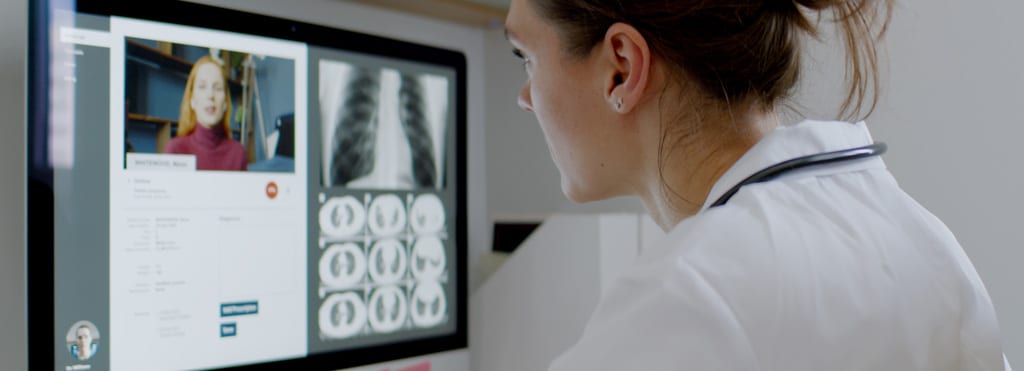The 2020 Telehealth Acceleration
During a pandemic, the last place people want to be is at a hospital, medical center, or doctor’s office around potentially ill patients. COVID-19 concerns are dramatically increasing interest in and adoption of telehealth services.
According to a survey from a recent Forbes article, 59% of respondents are more likely to use telehealth now than they were before the pandemic. A full third of people said that they would even be willing to leave their current health provider for an option that allows telemedicine. As much as telehealth was growing before the crisis, now it is on an even steeper climb towards universal adoption.
Providers have quickly increased the scale of there telehealth capabilities. One McKinsey study reported providers are treating 50 to 175 times more patients via telehealth services than before COVID-19. Reimbursement policy changes that facilitate online medical consultations have unleashed a new revenue opportunity for many healthcare providers. Telehealth services typically generated about $3 billion per year. The McKinsey analysts identified as much as $250 billion of current healthcare services could potentially be delivered virtually.
There are several reasons for this. One reason is that pre-Covid, telemedicine was primarily used for urgent care, especially in cases when patients were travelling for business or on vacation. Another common reason was if they could not get to their regular doctor quickly. In doing so, they often connected with a new, unfamiliar provider with whom they had no previous relationship. As telemedicine becomes more ubiquitous, virtual visits will no longer be limited to just quick-fix patient engagements, they may shift more towards being the standard.
As other articles have pointed out, a series of agreements between AV companies with collaborative tech, healthcare providers, insurance companies, and other stakeholders are beginning to create a new world of telehealth. Virtual consultations can be as simple as a quick text message to answer to a question and as sophisticated as two-way, interactive video communication complete with the exchange of objective patient data such as test results, radiology reports, images, or advanced virtual instrumentation readings.
This collaboration is leading to some surprising statistics. Another Forbes article recently cited a statistic from one particular medical center in New England that recently saw telehealth rates for routine visits go from 1% pre-COVID to 85%.
Virtual visits can now even include approvals for medicine or for helping patients get medical tests. The DEA recently relaxed some prescription restrictions allowed during virtual consultations. And while patients can receive some diagnostic medical tests virtually, there will still remain some medical tests that cannot be conducted via video conferencing. Providers can partner with other organizations with locations near patients’ homes or offices to offer these services. The convenience provided for your patients to get a radiology test or blood drawn if they only have to spend a few minutes at a local testing lab or pharmacy clinic is immeasurable while still allowing the higher value consultations and planning to be conducted separately online.
All this serves to show that the collaborations inherent in telehealth are forming powerful trends to meet the rapidly rising needs of the current era.
The Next Steps for Optimizing Telemedicine at Your Organization
As you plan how to meet your business goals and best support your providers and patients with telehealth technologies. Here are some cohesive steps you can take to push in that direction:
Gather information
Begin by analyzing your current patient experience patterns and how new technologies might be able to enhance and simplify them. VSGI’s AV integration teams can help you assess both your service delivery goals and your current technical infrastructure (AV equipment, video conferencing platforms, and IT networks) to help you create an implementation plan.
Consolidate, integrate and simplify your platforms
Many hospitals, medical centers, and healthcare networks have a variety of collaboration platforms. Some teams and departments may have chosen different solutions over time. Other platforms may have been added through mergers and acquisitions. That’s why the VSGI Meetings platform is architected to be highly interoperable and flexible. It allows patients, providers, and even SIP-based diagnostic equipment to seamlessly connect using their preferred services and equipment. These might include Cisco, Poly, Microsoft Teams, Zoom, Google Hangouts, and many others.
Consider your user training and ongoing user support options
Consolidating your systems down to one flexible, integrated system significantly simplifies training. However, ongoing training, tech support, and user adoption programs also add a lot of value. Additionally, technical support programs for patients is vital for your success in the long-term. Options like VSGI can help you design and implement a comprehensive support program to optimize your ROI for your telehealth programs, guiding you towards making the most beneficial decisions.
Getting Started
Once you have a better sense of what your telehealth service goals will be, it’s important to be proactive during implementation. The world is on the ground floor of a telemedicine explosion, and the organizations that are the most energetic about moving quickly towards implementation will most benefit from this explosion.
This doesn’t mean necessarily jumping the gun, but it does mean getting serious about acting on what you’ve learned. Making sure all of your systems are fully integrated – not siloed piecemeal point solutions – is key to continuing to scale profitably. Now that patients have experienced the convenience of virtual services and overcome uncertainties about using video conferencing technologies, experts forecast permanent changes in patient experience expectations, including:
A sense of safety
Patients want to avoid going to places where there may be a number of other sick people to get care.
Geographic flexibility
People can receive telemedicine help no matter where they are or what they are doing. Medical problems don’t automatically respect your plans, after all.
Time flexibility
Virtual appointments save patients a significant amount of time. There’s no traffic hassle to drive to a facility, no boring waiting rooms, and therefore less time away from work.
Provider flexibility
As long as your services are still within the patient’s insurance network, they can utilize them
Planning for the Future
COVID-19 related telehealth demand is expected to continue increasing for the next 12-18 months – certainly, until reliable treatments and vaccines reach the market. However, patient preferences and service expectations have changed forever. McKinsey reports that 76% of patients surveyed said they are highly or moderately likely to telehealth going forward. Count on VSGi to be your team’s trusted partner to help optimize your AV technologies and ensure all your systems are seamlessly integrated to help you deliver effective, profitable telehealth services.

